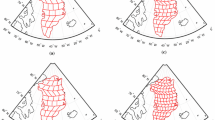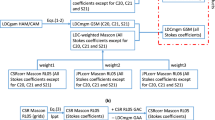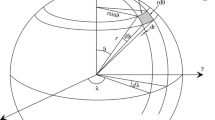Abstract
We present a new global time-variable gravity mascon solution derived from Gravity Recovery and Climate Experiment (GRACE) Level 1B data. The new product from the NASA Goddard Space Flight Center (GSFC) results from a novel approach that combines an iterative solution strategy with geographical binning of inter-satellite range-acceleration residuals in the construction of time-dependent regularization matrices applied in the inversion of mascon parameters. This estimation strategy is intentionally conservative as it seeks to maximize the role of the GRACE measurements on the final solution while minimizing the influence of the regularization design process. We fully reprocess the Level 1B data in the presence of the final mascon solution to generate true post-fit inter-satellite residuals, which are utilized to confirm solution convergence and to validate the mascon noise uncertainties. We also present the mathematical case that regularized mascon solutions are biased, and that this bias, or leakage, must be combined with the estimated noise variance to accurately assess total mascon uncertainties. The estimated leakage errors are determined from the monthly resolution operators. We present a simple approach to compute the total uncertainty for both individual mascon and regional analysis of the GSFC mascon product, and validate the results in comparison with independent mascon solutions and calibrated Stokes uncertainties. Lastly, we present the new solution and uncertainties with global analyses of the mass trends and annual amplitudes, and compute updated trends for the global ocean, and the respective contributions of the Greenland Ice Sheet, Antarctic Ice Sheet, Gulf of Alaska, and terrestrial water storage. This analysis highlights the successful closure of the global mean sea level budget, that is, the sum of global ocean mass from the GSFC mascons and the steric component from Argo floats agrees well with the total determined from sea surface altimetry.












Similar content being viewed by others
Change history
31 July 2019
In the originally published version of the article, Eq. (15) is shown incorrectly.
References
AG WJ, Zhong S (2013) Computations of the viscoelastic response of a 3-D compressible Earth to surface loading: an application to Glacial Isostatic Adjustment in Antarctica and Canada. Geophys J Int 192(2):557–572. https://doi.org/10.1093/gji/ggs030
Carrère L, Lyard F (2003) Modeling the barotropic response of the global ocean to atmospheric wind and pressure forcing-comparisons with observations. Geophys Res Lett 30(6):1275–1278. https://doi.org/10.1029/2002G016473
Cazenave A, Henry O, Munier S et al (2012) Estimating ENSO Influence on the Global Mean Sea Level, 1993–2010. Mar Geodesy 35:82–97. https://doi.org/10.1080/01490419.2012.718209
Cheng MK, Tapley BD, Ries JC (2013) Deceleration in the Earth’s oblateness. J Geophys Res 118:1–8. https://doi.org/10.1002/jgrb.50058
Donoho DL, Johnstone IM (1994) Ideal spatial adaptation by wavelet shrinkage. Biometrika 81(3):425–455. https://doi.org/10.1093/biomet/81.3.425
Foster M (1961) An application of the Wiener–Kolmogorov smoothing theory to matrix inversion. J Soc Ind Appl Math 9(3):387–392. https://doi.org/10.1137/0109031
Hoerl A, Kennard R (1970) Ridge regression: biased estimation for nonorthogonal problems. Technometrics 12(1):55–67. https://doi.org/10.2307/1267351
Ivins ER, James TS, Wahr J, Schrama EJO, Landerer FW, Simon KM (2013) Antarctic contribution to sea level rise observed by GRACE with improved GIA correction. J Geophys Res Solid Earth 118:3126–3141. https://doi.org/10.1002/jgrb.50208
Kim JR (2000) Simulation study of a low-low satellite-to-satellite tracking mission. Ph.D. thesis, University of Texas at Austin
Kusche J (2003) Noise variance estimation and optimal weight determination for GOCE gravity recovery. Adv Geosci 1:81–85. https://doi.org/10.5194/adgeo-1-81-2003
Kusche J, Springer A (2017) Parameter estimation for satellite gravity field modeling. In: Naeimi M, Flury J (eds) Global gravity field modeling from satellite-to-satellite tracking data. Lecture notes in Earth system sciences. Springer, Berlin, pp 127–160. https://doi.org/10.1007/978-3-319-49941-3_4
Lee J, Lund R (2004) Revisiting simple linear regression with autocorrelated errors. Biometrika 91(1):240–245. https://doi.org/10.1093/biomet/91.1.240
Lemoine FG, Goosens S, Sabaka TJ et al (2013) High–degree gravity models from GRAIL primary mission data. J Geophys Res Planets 118:1676?1698. https://doi.org/10.1002/jgre.20118
Leuliette E, Willis J (2011) Balancing the sea level budget. Oceanography 24(2):122–129. https://doi.org/10.5670/oceanog.2011.32
Loomis BD, Luthcke SB (2014) Optimized signal denoising and adaptive estimation of seasonal timing and mass balance from simulated GRACE-like regional mass variations. Adv Adapt Data Anal 06:1450003. https://doi.org/10.1142/S1793536914500034
Loomis BD, Luthcke SB (2017) Mass evolution of Mediterranean, Black, Red, and Caspian Seas from GRACE and altimetry: accuracy assessment and solution calibration. J Geod 91(2):195–206. https://doi.org/10.1007/s00190-016-0952-3
Luthcke SB, Zwally HJ, Abdalati W, Rowlands DD, Ray RD, Nerem RS, Lemoine FG, McCarthy JJ, Chinn DS (2006) Recent Greenland ice mass loss by drainage system from satellite gravity observations. Science 314(5803):1286–1289. https://doi.org/10.1126/science.1130776
Luthcke SB, Arendt AA, Rowlands DD, McCarthy JJ, Larsen CF (2008) Recent glacier mass changes in the Gulf of Alaska region from GRACE mascon solutions. J Glaciol 54(188):767–777. https://doi.org/10.3189/002214308787779933
Luthcke SB, Sabaka TJ, Loomis BD, Arendt AA, McCarthy JJ, Camp J (2013) Antarctica, Greenland and Gulf of Alaska land ice evolution from an iterated GRACE global mascon solution. J Glaciol 59(216):613–631. https://doi.org/10.3189/2013JoG12J147
Menke W (2015) Review of the generalized least squares method. Surv Geophys 36:1–25. https://doi.org/10.1007/s10712-014-9303-1
Nerem RS, Chambers DP, Choe C, Mitchum GT (2010) Estimating mean sea level change from the TOPEX and Jason altimeter missions. Mar Geodesy 33(1):435–446. https://doi.org/10.1080/01490419.2010.491031
Pavlis NK, Holmes SA, Kenyon SC, Factor JK (2012) The development and evaluation of the Earth Gravitational Model 2008 (EGM2008). J Geophys Res 117:B04406. https://doi.org/10.1029/2011JB008916
Peltier WR, Argus DF, Drummond R (2015) Space geodesy constrains ice-age terminal deglaciation: the global ICE-6G C (VM5a) model. J Geophys Res Solid Earth 120:450–487. https://doi.org/10.1002/2014JB011176
Phillips T, Nerem RS, Fox-Kemper B, Famiglietti JS, Rajagopala B (2012) The influence of ENSO on global terrestrial water storage using GRACE. Geophys Res Lett 39:L16705. https://doi.org/10.1029/2012GL052495
Reager JT, Gardner AS, Famiglietti JS, Wiese DN, Eicker A, Lo MH (2016) A decade of sea level rise slowed by climate-driven hydrology. Science 351:699–703. https://doi.org/10.1126/science.aad8386
Rodell M, Famiglietti JS, Wiese DN, Reager JT, Beaudoing HK, Landerer FW, Lo MH (2018) Emerging trends in global freshwater availability. Nature 557(7707):651–659. https://doi.org/10.1038/s41586-018-0123-1
Rowlands DD, Ray RD, Chinn DS, Lemoine FG (2002) Short-arc analysis of intersatellite tracking data in a gravity mapping mission. J Geod 76:307. https://doi.org/10.1007/s00190-002-0255-8
Rowlands DD, Luthcke SB, Klosko S, Lemoine FG, Chinn DS, McCarthy JJ, Cox CM, Anderson OB (2005) Resolving mass flux at high spatial and temporal resolution using GRACE intersatellite measurements. Geophys Res Lett 32:L04310. https://doi.org/10.1029/2004GL021908
Rowlands DD, Luthcke SB, McCarthy JJ, Klosko SM, Chinn DS, Lemoine FG, Boy J-P, Sabaka TJ (2010) Global mass flux solutions from GRACE: a comparison of parameter estimation strategies - mass concentrations versus Stokes coefficients. J Geophys Res 115:B01403. https://doi.org/10.1029/2009JB006546
Sabaka TJ, Rowlands DD, Luthcke SB, Boy J-P (2010) Improving global mass flux solutions from Gravity Recovery and Climate Experiment (GRACE) through forward modeling and continuous time correlation. J Geophys Res 115:B11403. https://doi.org/10.1029/2010JB007533
Save H, Bettadpur S, Tapley BD (2016) High resolution CSR GRACE RL05 mascons. J Geophys Res Solid Earth 121:7547–7569. https://doi.org/10.1002/2016JB013007
Savitzky A, Golay MJE (1964) Smoothing and differentiation of data by simplified least squares procedures. Anal Chem 36(8):1627–39. https://doi.org/10.1021/ac60214a047
Scanlon BR, Zhang Z, Save H et al (2018) Global models underestimate large decadal declining and rising water storage trends relative to GRACE satellite data. PNAS. https://doi.org/10.1073/pnas.1704665115
Shepherd A, Ivins ER et al (2012) A reconciled estimate of ice-sheet mass balance. Science 338(6111):1183–1189. https://doi.org/10.1126/science.1228102
Shepherd A et al (2018) Mass balance of the Antarctic Ice Sheet from 1992 to 2017. Nature 558(7709):219–222. https://doi.org/10.1038/s41586-018-0179-y
Swenson S, Chambers D, Wahr J (2008) Estimating geocenter variations from a combination of GRACE and ocean model output. J Geophys Res 113:B08410. https://doi.org/10.1029/2007JB005338
Tikhonov AN (1963) Solution of incorrectly formulated problems and the regularization method. Sov Math Dokl 4:1035–1038
Wahr J, Molenaar M, Bryan F (1998) Time variability of the Earth’s gravity field: Hydrological and oceanic effects and their possible detection using GRACE. J Geophys Res Solid Earth 103(B12):30,205–30,229. https://doi.org/10.1029/98JB02844
Wahr J, Swenson S, Velicogna I (2006) Accuracy of GRACE mass estimates. Geophys Res Lett 33:L06401. https://doi.org/10.1029/2005GL025305
Wahr J, Nerem RS, Bettadpur SV (2015) The pole tide and its effect on GRACE time-variable gravity measurements: implications for estimates of surface mass variations. J Geophys Res Solid Earth 120:4597–4615. https://doi.org/10.1002/2015JB011986
Watkins MM, Wiese DN, Yuan D-N, Boening C, Landerer FW (2015) Improved methods for observing Earth’s time variable mass distribution with GRACE using spherical cap mascons. J Geophys Res Solid Earth. https://doi.org/10.1002/2014JB011547
WCRP Global Sea Level Budget Group (2018) Global sea level budget 1993-present. Earth Syst Sci Data 10:1551–1590. https://doi.org/10.5194/essd-10-1551-2018
Weigelt M (2017) The acceleration approach. In: Naeimi M, Flury J (eds) Global gravity field modeling from satellite-to-satellite tracking data. Lecture notes in Earth system sciences. Springer, Berlin, pp 127–160. https://doi.org/10.1007/978-3-319-49941-3_4
Wiese DN, Landerer FW, Watkins MM (2016) Quantifying and reducing leakage errors in the JPL RL05M GRACE mascon solution. Water Resour Res 52:7490–7502. https://doi.org/10.1002/2016WR019344
Acknowledgements
Support for this work was provided by the NASA GRACE and GRACE Follow-On Science Team Grant NNH15ZDA001N. We acknowledge the quality of the GRACE Level-1B products produced by our colleagues at the Jet Propulsion Laboratory. We also acknowledge the numerous contributions of D.D. Rowlands, K.E. Rachlin, and J.B. Nicholas in developing the algorithms and software necessary to carry out this research, and we thank the three anonymous reviewers and the editors who provided valuable feedback toward improving this manuscript. The MEI is provided at https://www.esrl.noaa.gov/psd/enso/mei/.
Author information
Authors and Affiliations
Corresponding author
Least-squares and statistical assumptions
Least-squares and statistical assumptions
1.1 Introduction
Linear least-squares parameter estimation and error assessment typically rely on a set of statistical assumptions that may not be valid. Here, we examine the effect of the assumed statistical properties of the linear system of equations on the bias and covariance of the least-squares state estimator, \(\hat{\mathbf {x}}\). We are specifically interested in the properties of the a priori state equation, which we show defines the bias of the estimator, and must be accounted for when assessing the error of the mascon parameters.
We begin by defining linear system of equations for the assumed and truth cases:
where J is the least-squares cost function to be minimized by the parameters of interest \(\mathbf {x}\), \(\mathbf {d}\) is the data vector, \(\mathbf {A}\) is the design matrix, \(\mathbf {x}_a\) is the a priori best estimate of the true mean state \(\mathbf {x}_m\) of \(\mathbf {x}\), and \(\mathbf {W}^{-1}\), \(\mathbf {R}^{-1}\), \(\mathbf {P}^{-1}\), and \(\mathbf {Q}^{-1}\) are the covariance matrices of the various zero-mean errors \({\nu }\), \({\zeta }\), \({\eta }\), and \({\epsilon }\), respectively. The errors in statistical information considered here arise in the a priori information as misspecifications in the mean and covariance of the distribution of x, that is, the difference between \(\mathbf {x}_a\) and \(\mathbf {x}_m\) and the difference between \(\mathbf {P}\) and \(\mathbf {Q}\), respectively, and misspecification in the covariance of the data noise, that is, the difference between \(\mathbf {W}\) and \(\mathbf {R}\). The least-squares minimizer of J for the assumed statistical information is given by:
1.2 The dispersion matrix and mean squared error
The stochastic processes considered here are assumed second-order stationary, and thus, are completely explained by their mean and covariance. For a vector stochastic process z, these are related by considering the expected value of the total variation, or dispersion, between all pairs of elements, which can be assembled into a dispersion matrix \(\mathbf {D}_z\) that can decomposed as follows:
where \(\mathbb {E}[\cdot ]\) is the expectation operator, \(\mathbf {C}_z\) is the covariance matrix of z, and \(\mathbf {z}_m=\mathbb {E}[\mathbf {z}]\) is the mean vector.
The mean squared error (MSE) of the estimate is then defined as follows:
where \(Tr[\cdot ]\) is the trace operator and \(\mathbf {b}=\mathbb {E}[\hat{\mathbf {x}}-\mathbf {x}]\) is the estimate bias vector. Therefore, we see that the error-covariance matrix \(\mathbf {C}_{\hat{x}-x}\) and bias vector b completely define the discrepancy between \(\hat{\mathbf {x}}\) and \(\mathbf {x}\).
1.3 Error covariance and bias
We now rewrite the true statistics of the underlying true state x as:
where \(\mathbf {x}_b = \mathbf {x}_a - \mathbf {x}_m\), and substitute this and \(\mathbf {d} = \mathbf {A} \mathbf {x} + {\zeta }\) into A.2 such that
The error may now be written as
whose expected value, or bias \(\mathbf {b}\), is
If we define the a priori value of \(\mathbf {x}_a\) to be zero, as is the case for GSFC mascon estimation, then this can be rewritten as
where \(\mathbf {R}\) is the resolution operator defined in Eq. 18. As previously noted, the solution bias of Eq. A.9 matches the ridge regression bias presented by (Hoerl and Kennard 1970). To derive the covariance, we note that
which leads to
where it has been assumed that \(\mathbb {E}[{\zeta \epsilon }^\mathrm {T}]=0\).
To conclude, we observe in Eqs. A.9 and A.11 the effect of invalid statistical assumptions on the bias and covariance, respectively. If the covariance statistics are assumed to be valid, that is, \(\mathbf {W}=\mathbf {R}\) and \(\mathbf {P}=\mathbf {Q}\), then Eq. A.11 reduces to the familiar form:
It can be shown that \(\mathbf {C}^\prime _{\hat{\mathbf {x}} - \mathbf {x}} > \mathbf {C}_{\hat{\mathbf {x}} - \mathbf {x}}\), which indicates that this difference in symmetric positive-definite matrices is itself a symmetric positive-definite matrix, that is, it has positive eigenvalues. This means that any variance produced through covariance propagation will be larger for \(\mathbf {C}^\prime _{\hat{\mathbf {x}} - \mathbf {x}}\) than the corresponding variance produced by \(\mathbf {C}_{\hat{\mathbf {x}} - \mathbf {x}}\).
Rights and permissions
About this article
Cite this article
Loomis, B.D., Luthcke, S.B. & Sabaka, T.J. Regularization and error characterization of GRACE mascons. J Geod 93, 1381–1398 (2019). https://doi.org/10.1007/s00190-019-01252-y
Received:
Accepted:
Published:
Issue Date:
DOI: https://doi.org/10.1007/s00190-019-01252-y




